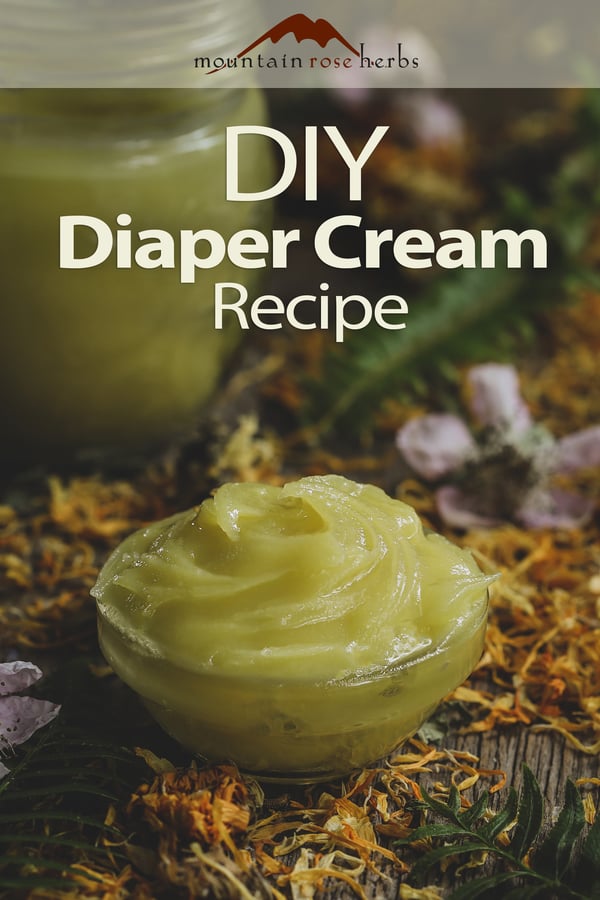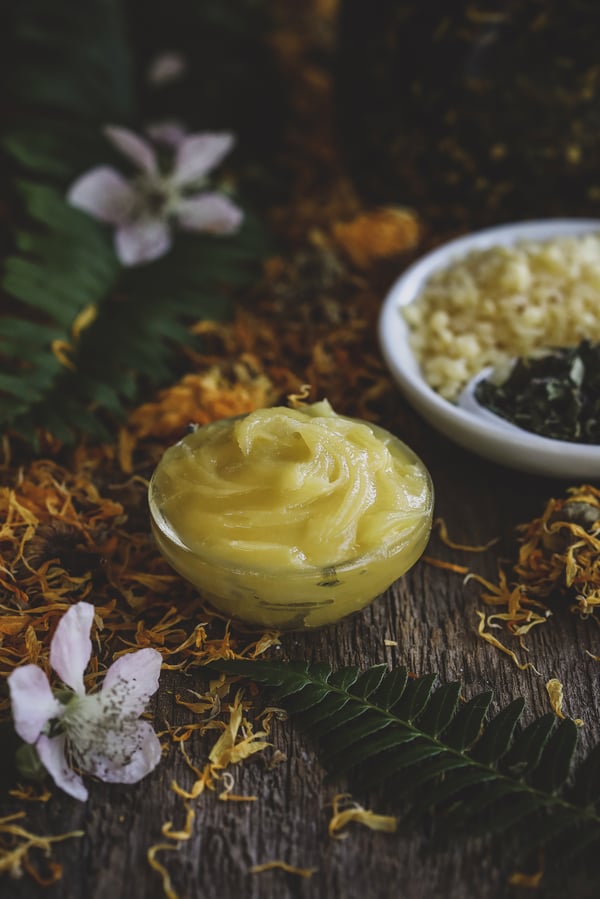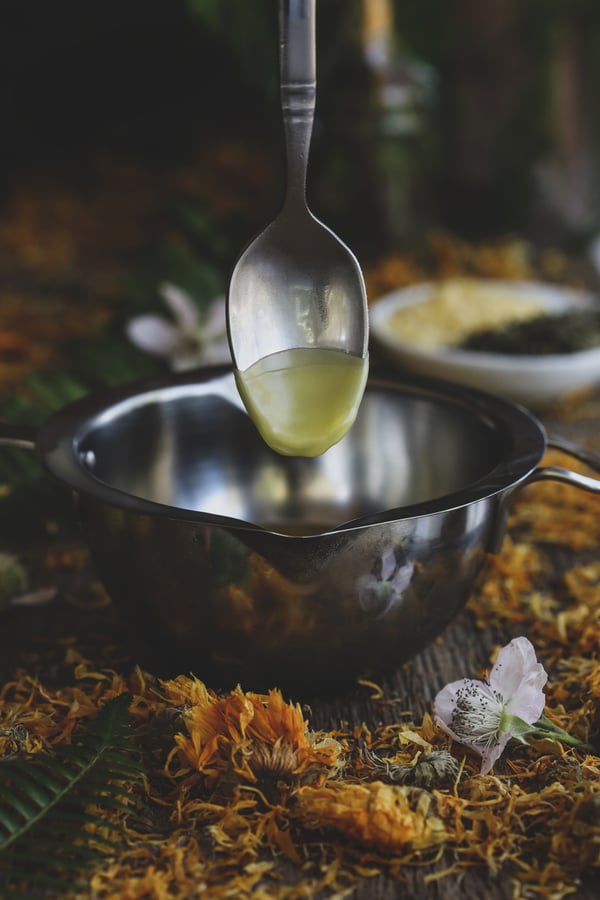My grandbaby is now officially a toddler: talking up a storm, climbing everything, and making all day every day an adventure. I am realizing that this little sweetie might very well be the last baby in our family for a long time, so I am being extra conscious to appreciate every moment of development and growth. Last week my son stopped by to pick up a few more jars of homemade diaper balm to take home with him, and I made a mental note that I’d better start infusing some more olive oil because they’ll need another batch of ointment before this little one is potty trained. As we were waving our boy out the door, my husband asked me, “How much diaper salve do you suppose you’ve made in your life?” Three children, a grandchild, and a lot of friends’ babies later, I can’t even begin to guess. Gallons upon gallons I suppose.
I can’t claim this recipe as my own because it is built on common ointment ratios and generations of collective herbal wisdom about the most soothing herbs for sensitive skin. Calendula and Oregon Grape root have proven themselves to be gentle and effective at protecting and soothing not just babies’ diapered bottoms, but also adult skin irritations, minor scrapes, etc. This is why, when I realized it was time to infuse another batch of olive oil, I knew I’d be making more of this salve even after my grandbaby is long out of diapers because it’s handy to have a soothing herbal ointment around for a whole variety of skin issues. When this one is potty trained, I’ll just change the label on the jars from “diaper balm” to “herbal ointment.”
Note: For many, many years I included comfrey leaf (Symphytum officinale) in this balm. I have recently made the decision to discontinue this practice. Here is why: We have long known that comfrey contains pyrrolizidine alkaloids (PAs). Some of these alkaloids, when ingested internally over time, can cause liver damage. Because PAs do not absorb easily through healthy skin, comfrey has been considered safe to use topically on unbroken skin. However, recent research has led me to reconsider long-term topical use, even on healthy skin. Professionals now recommend limiting topical use of comfrey and other PA-containing herbs to a few weeks at a time. Therefore, I no longer recommend adding comfrey to diaper balm.
Herb-Infused Organic Olive Oil
Ingredients
Directions
- Place equal parts of each herb in a sterilized, dry quart jar, leaving enough room for oil.
- Cover herbs completely with organic olive oil so that oil is 1-2 inches over herbs.
- Cover jar tightly with a good sterilized, dry lid.
- Place jar in a warm, dark cabinet to infuse for two weeks. Gently shake jar each day. Add more oil as necessary to keep herbs completely covered.
- Strain oil through cheesecloth and squeeze to get every drop of the infused oil. Compost used herbs.
- Repeat step 1 with new herbs: place equal parts herbs in a new sterilized, dry quart jar until half full. Pour in already infused oil to completely cover.
- Infuse for two more weeks, adding more oil to top if necessary.
- Strain oil through cheesecloth, squeeze out all herbal oil, and compost herbs.
- Label bottle with name and date. Seal well and store in a cool, dark location. Stored properly, this oil will keep for up to one year.
Pro Tips
- Many herbalists prefer to solar-infuse herbs in oil in a sunny window. This is particularly wonderful with herbs like St. Johns Wort.
- If you don’t have enough time to infuse your oil slowly, you can use a quick method. Place equal parts herbs in a crock-pot, double boiler, or electric yogurt maker and cover with organic olive oil. Make sure oil covers herbs by at least 1-2 inches. Gently heat over very low heat—keep oil at about 110° F for 4 hours, until oil takes on color and scent of herbs. Some texts recommend heating oil at a controlled temperature of 100° F for 48-72 hours. Turn off heat and allow to cool before straining herbs.
Herbal Diaper Ointment
Makes about 1 cup
Ingredients
- 1 cup herb-infused organic olive oil (see above)
- 1/4 cup grated beeswax or beeswax pastilles (approximate 35 grams)
- 6 drops Non-GMO Verified Vitamin E oil
Directions
- Put a metal spoon in the freezer.
- In the top of a double boiler over medium-low heat combine oil and beeswax.
- Heat until beeswax has melted, and mixture is incorporated.
- Dip the spoon from the freezer into the pot. If the oil no longer drips off the spoon, the salve is ready for containers. If it drips, add a little more beeswax. If it seems too stiff, add more oil. Alternatively, you can also pour a little of the oil/beeswax mixture into the spoon and place it back in the freezer for 1-2 minutes to get a better sense of the final consistency.
- Remove from heat.
- After mixture has cooled slightly, but before it starts to solidify, stir in vitamin E oil.
- Pour warm oil into tins or upcycled glass jars with lids.
- Allow salve to cool completely before placing lids on containers.
- Remember to label your containers!
- Store in a cool, dry place. If stored properly, salves can last 2 to 3 years.
Pro Tip
- If your child develops a diaper rash that does not improve with ointment, please contact your doctor to see if baby has a yeast (Candida) rash that may require a more specific antifungal cream.
Want to make more gentle skincare products for your baby?
Check out This Homemade Baby Powder Recipe!
You may also enjoy:
- Homemade Mama & Baby Massage Oil Recipe
- Zero-Waste Homemade Herbal Baby Wipes
- Homemade Organic Baby Food Recipes with Herbs & Spices














